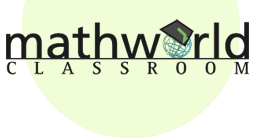Topics in a Topology Course
To learn more about a topic listed below, click the topic name to go to the
corresponding MathWorld classroom page.
General
| Differential Topology |
Differential topology is the mathematical study of smooth manifolds. |
| Dimension |
Dimension is a topological measure of the size of an object's covering properties, roughly corresponding to the number of coordinates needed to specify a point on the object. |
| Homology |
Homology is a mathematical concept used in many branches of algebra and topology that involves a topological invariant known as a homology group. |
| Homotopy |
A continuous deformation of a topological space or a function between two topological spaces. |
| Knot |
A closed, nonself-intersecting curve that is embedded in three dimensions and that cannot be untangled to produce a simple loop. |
| Link |
A link is an assembly of knots with mutual entanglements. |
| Manifold |
A manifold is a topological space that is locally Euclidean, i.e., around every point, there is a neighborhood that is topologically the same as an open unit ball in some dimension. |
| Metric |
A metric is a nonnegative function describing the distance between neighboring points for a given set. |
| Metric Space |
A metric space is a set with a global distance function that for every two of the set's points gives the distance between them as a nonnegative real number. |
| Möbius Strip |
A Moebius strip is one-sided nonorientable surface obtained by cutting a closed band into a single strip, giving it half a twist, and then reattaching the two ends. |
| Projective Plane |
The projective plane is the set of lines in the Euclidean plane that pass through the origin. It can also be viewed as the Euclidean plane together with a line at infinity. |
| Projective Space |
Projective space is the generalization of the projective plane to more than two dimensions. |
| Tangent Space |
A tangent space is a vector space of all possible tangent vectors to a point on a manifold. |
| Topology |
(1) As a branch of mathematics, topology is the mathematical study of object's properties that are preserved through deformations, twistings, and stretchings. (2) As a set, a topology is a set along with a collection of subsets that satisfy several defining properties. |
| Torus |
A torus is a closed surface containing a single hole that is shaped like a doughnut. |
| Vector Bundle |
Given a topological space X, a vector bundle is a way of associating a vector space to each point of X in a consistent way. |
Point-Set Topology
| Closed Set: |
A closed set is a subset of a topological space that contains all of its limit points. A closed interval is an example of a closed set. |
| Homeomorphism: |
A homeomorphism is ann equivalence relation and one-to-one correspondence that is continuous in both directions between points in two geometric figures or topological spaces. |
| Neighborhood: |
The neighborhood of a point is an open set containing that point. |
| Open Set: |
An open set is a set for which every point in the set has a neighborhood lying in the set. An open set is the complement of a closed set and. An open interval is an example of an open set. |
| Point-Set Topology: |
Point-set topology is the study of the general abstract nature of continuity on spaces. Basic point-set topological notions are ones like continuity, dimension, compactness, and connectedness. |
| Subspace: |
A subspace is a subset of a vector space that is also itself a vector space. This term can also be used for a subset of a topological space. |
| Topological Space: |
A topological space is a set with a collection of subsets T that together satisfy a certain set of axioms defining the topology of that set. |
|

